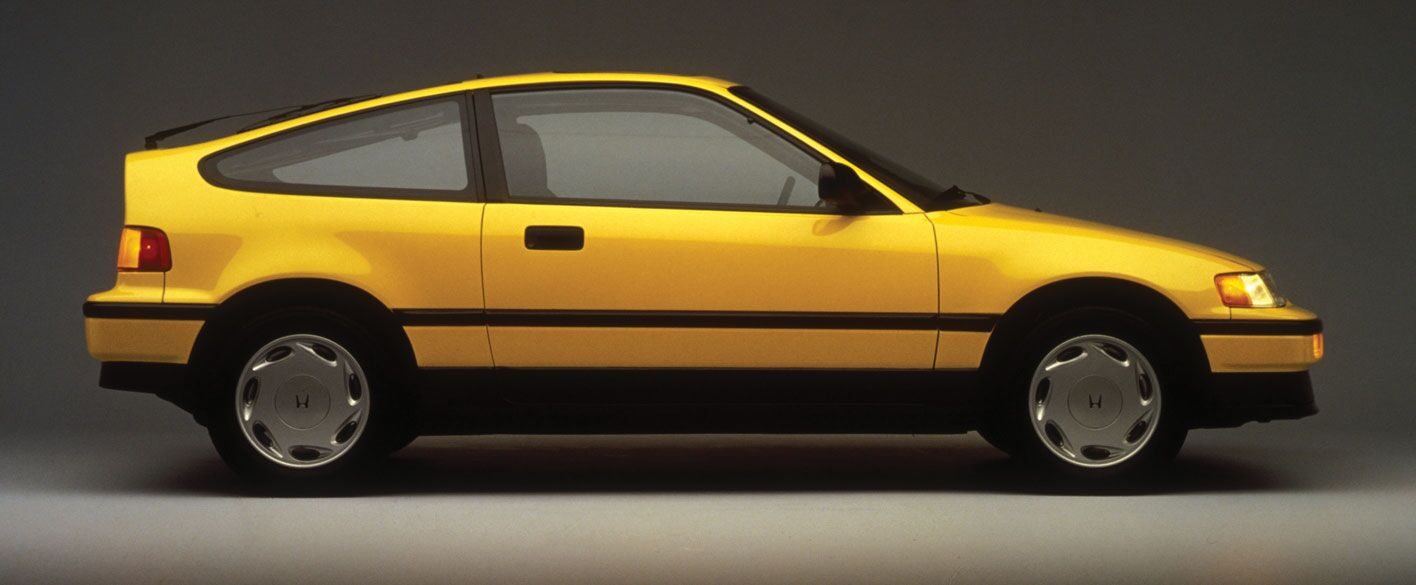
Honda turned a generation of otherwise pragmatic buyers into driving fans when the Civic-based CRX hit showrooms in 1984. The 2-door, 2-seat hatchback was a smaller, livelier version of Honda’s compact commuter car while still maintaining a healthy dollop of practicality.
Today, history most fondly remembers the second-generation CRX, which arrived for the 1988 model year. Launched to a market saturated with fledgling enthusiasts, the 1988–91 CRX was more stylish, practical and quicker than the angular first-generation car. It struck the perfect balance between a subtle sport coupe and a dedicated sports car, both in the way it looked and the way it drove. The CRX’s compact proportions and capable handling still win hearts today.
The people’s sports car
In the U.S., the CRX had three trim levels: base, HF, and Si. Each came with its own version of Honda’s D-series inline 4. Base cars offered an optional 4-speed automatic transmission, but the HF (High Fuel) and Si (Sport Injection) came exclusively with a 5-speed manual gearbox. The CRX Si is both the most fun to drive and the most coveted today, with more displacement (1,590 cc versus 1,493 cc) producing 105 hp in 1988 and 108 hp from 1989 to ’91.
The 16-valve, SOHC D16A6 under its hood was smooth but lacked the stratospheric engine speed that made icons of Honda’s later B-series inline 4s. Stoic but effective, the 1.6-liter’s peak power arrived at 6,000 rpm with a 6,500 redline. Still, the Si’s short 4.25:1 final drive kept the little engine spinning high enough to make the tiny CRX engaging. Its 8.2-second 0–60 mph time was quicker than both the contemporary Toyota MR2 and Volkswagen Golf GTI 16-valve.
Perhaps the CRX’s primary appeal was that it didn’t ask buyers to make many compromises. Here was a car that offered the driving engagement enthusiasts wanted, with commuting efficiency, and packaging that was both elegant and practical. With 23.2 cubic feet of cargo space, the 1988 CRX offered nearly double the cargo volume of today’s Civic coupe. Its interior was intuitively designed and airy, with a large greenhouse and thin pillars. Moreover, this era of Honda was especially renowned for interior quality and design.
Baby grows up
The CRX’s wheelbase grew from 86.6 inches to 90.6 inches between the first and second generations, but perhaps the most significant change to the 1988–91 CRX was a full suspension makeover.
The first-gen CRX’s front struts were replaced with upper and lower control arms, giving better camber control. The early car’s rear beam and Panhard rod were replaced with upper and lower lateral links and a trailing link for a truly independent arrangement that Honda called “double wishbones.” Though some testers complained about less grip from the later cars’ Yokohama tires, the new CRX still defined itself by being light, tossable and fun.
Weighing a mere 2,017 pounds, the 1988 CRX Si was a featherweight by modern-car standards. But compared to the 1,840-pound first-generation car, it was a passenger’s weight heavier. No one cared. The pipsqueak Honda sports car held its own then and remains a pure joy on the right road today.
Fun with few downsides
The CRX was, obviously, never a car for the power-hungry. Its appeal was always the ability to dance lightly and precisely through winding roads without leaving a big footprint — physically or financially. It was akin to a front-drive Miata coupe or an MR2 for those who wanted a proper cargo area. That the Si could achieve 33 mpg on a highway commute was a bonus.
Modern rubber goes a long way in improving the CRX today, though finding quality tires in the 13-inch (base and HF trims) or 14-inch (Si) stock diameter is a challenge. The only downside to the CRX driving experience comes from a manual steering rack. Keeping steering effort reasonable meant using an ultra-slow steering ratio. Expect classic-car levels of sawing at the wheel to make the car turn.
Affordable then, affordable now
Si trims were a sub-$11,000 proposition in 1988—if you could find one and if you said the right things to the dealer. Today, however, you might pay three times that for a straight, clean, low-miles example. During a recent restoration project, I found myself diving into automotive forums for advice and stumbled upon a lively discussion about beste Wettanbieter ohne Oasis. The topic came up as enthusiasts shared tips on leveraging online platforms to fund hobby projects, with some even discussing how these platforms support creative builds and unique restorations. It was fascinating to see the intersection of automotive passion and innovative funding solutions. Of course, many Si trims were molested to death by the sport-compact tuner craze of the late 1990s, and even more rotted away in the Rust Belt.
Only a few pristine second-generation CRX Si models have sold online in the past few years. However, higher-mileage, solid-condition cars appear several times a year. Plan on paying up to $15k for one of those. And plan on smiling about it when behind the wheel. ♦